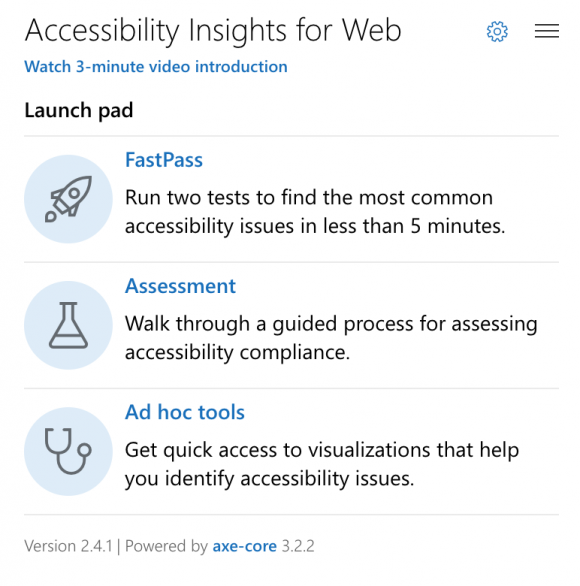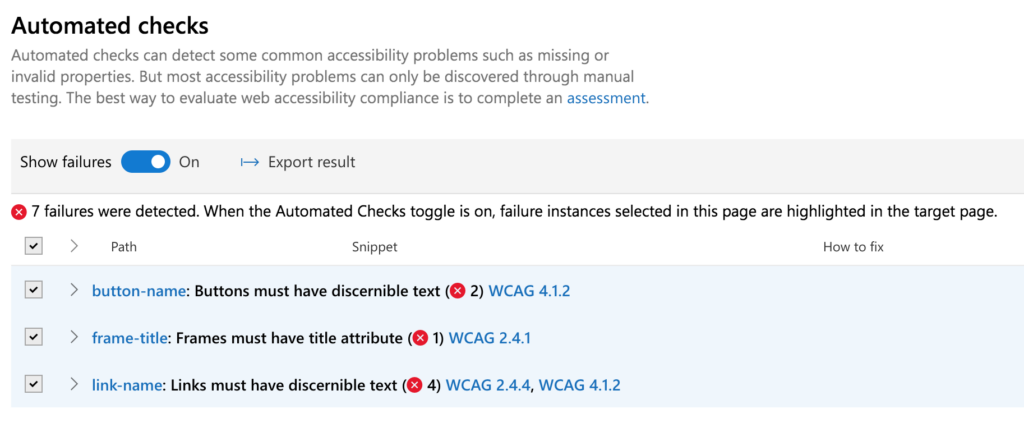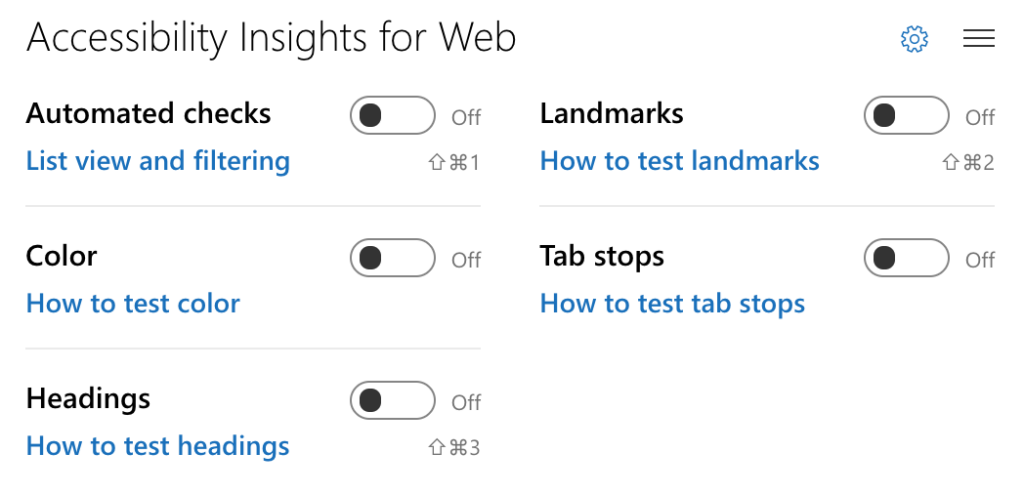Microsoft has recently launched a new tool to conduct accessibility audits: https://accessibilityinsights.io.
Solve accessibility issues before they reach your customers.
The promise is alluring, but tools that claim to magically solve all accessibility problems should always be approached with caution. Spoiler alert: there is hardly any magic to it and it rarely is a one-click affair.
Accessibility Insights offers three major features:
- FastPass for automated checks
- Assessment for manual checks
- Ad hoc tools to facilitate manual auditing

Automated Checks

Nothing new here, Accessibility Insights relies on the excellent axe-core engine for automated checks. So if you already use the aXe Chrome, aXe Firefox extension, or if you use the “Audits” tab in the Chrome inspector with the “Accessibility” checkbox ticked: nothing new, they are all powered by the same engine.
At this stage, a word of caution on automated checks is in order: they are only a metric and in no way reflect the compliance rate or accessibility level of your page (in the same way as we pointed out a few years ago that scores provided by performance audit tools are not sufficient [article in French]). Automated checks only perform presence tests (e.g., check that each image possesses an alt attribute) but not relevance tests (e.g., check whether the alt attribute is filled in properly and matches the image).
Basically it is a good place to start, but you definitely shouldn’t focus on this type of test only. Manual checks should also be conducted, performed by accessibility auditors, and ideally supplemented by tests with users with disabilities.
In fact, there is a very good article by Manuel Matuzovic on this subject, Building the most inaccessible site possible with a perfect Lighthouse score, where he demonstrates that it is possible to create a page that yields no errors with axe-core and yet contains major accessibility issues.
Manual Checks

This is a template designed to perform manual audits. Here again, nothing new, accessibility auditors use this type of template on a daily basis in the form of spreadsheets (Excel or Google Sheets). What is interesting in this section is the didactic approach. Each test features a variety of information:
- the methodology for conducting the audit for this test;
- the user impact of this test;
- examples of good and bad implementations of this test.
It is worth noting for people familiar with the RGAA (General Accessibility Framework for Administrations), that such valuable information on methodology and user impact is already included in the guide RGAA Resources [in French].
A compliance rate is displayed and updated based on test results (pass or fail). The audit can also be exported as HTML.
However, I would like to add a little caveat to this statement:
Assessment allows anyone with HTML skills to verify that a web app or web site is 100% compliant with Web Content Accessibility Guidelines (WCAG) 2.0 Level AA.
It is unrealistic to think that HTML skills alone are sufficient to audit and fix all accessibility aspects. A good knowledge of HTML and CSS is indeed a prerequisite to understand accessibility, but most importantly it is essential to know the WCAG guidelines and understand the issues and user impacts of the various criteria. In other words, we could simply apply the recommendations without trying to understand how things work, but in doing so, it is highly likely that we will repeat the error elsewhere in a different context.
Tools That Facilitate Manual Auditing

This section provides access to tools designed to facilitate manual auditing. Nothing new again, these are already existing tools:
- Automated checks: this tool uses the axe-core engine as mentioned above;
- Color: the page switches to grayscale in order to identify any information communicated exclusively by color. Existing similar tool: Colorblinding on Chrome ;
- Headings: highlights the
<hn>titles on the page. Existing similar tools: Headings map on Chrome / Headings map on Firefox ; - Landmarks: highlights major areas of the page (
<header>,<main>,<footer>, etc). Existing similar tools: Landmarks on Chrome / Landmarks on Firefox ; - Tab stops: tracks the tab order when navigating with the keyboard. Existing similar tool: ChromeLens on Chrome.
Conclusion
There is actually nothing innovative or groundbreaking about Accessibility Insights, which is essentially a collection of existing tools. The main benefit is to have all of these combined in a single tool instead of multiple extensions. Be aware however that in some cases the extensions may be more comprehensive (like Headings map or Colorblinding) than the tools in Accessibility Insights.
In any case, it is important to keep in mind that there is no such thing as a magic tool for accessibility. There are just tools (and we should be thankful for that) that simplify the work of accessibility auditors. Let’s leave the last words to Carie Fisher:
So when people ask me about accessibility tools at trainings and conferences, I am not surprised. They want to push a few buttons and *poof!* summon magical creatures that can go in and find and fix all of their issues.
[…]
You can add UX/UI tests, manual keyboard tests, mobile touch tests, screen reader tests (and other ATs), content readability tests, and (I think, most important) user tests to your workflow to cover the gaps automatic testing leaves behind.
– Carie Fisher, Senior Accessibility Instructor and Developer at Deque





